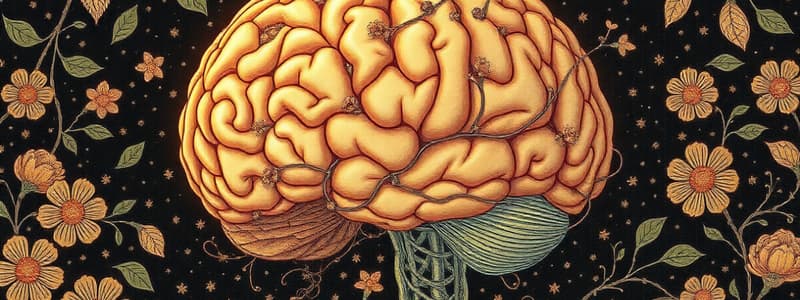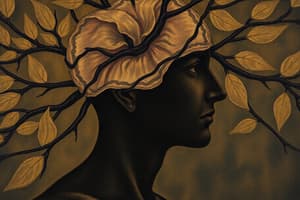Podcast
Questions and Answers
Which part of the nervous system is responsible for voluntary movements of skeletal muscles?
Which part of the nervous system is responsible for voluntary movements of skeletal muscles?
- Autonomic Nervous System
- Central Nervous System
- Somatic Nervous System (correct)
- Parasympathetic Nervous System
Which neurotransmitter is primarily associated with muscle action, learning, and memory?
Which neurotransmitter is primarily associated with muscle action, learning, and memory?
- Dopamine
- Acetylcholine (correct)
- Serotonin
- Norepinephrine
What function does the hypothalamus play in relation to biological rhythms?
What function does the hypothalamus play in relation to biological rhythms?
- Processes sensory information
- Controls voluntary movements
- Coordinates balance and posture
- Regulates sleep-wake cycles (correct)
Which of the following systems prepares the body for emergencies and stress?
Which of the following systems prepares the body for emergencies and stress?
What is the main role of the cerebellum in the brain?
What is the main role of the cerebellum in the brain?
What is the role of melatonin in the body?
What is the role of melatonin in the body?
Which neurotransmitter is primarily involved in regulating alertness and arousal?
Which neurotransmitter is primarily involved in regulating alertness and arousal?
Which brain structure is essential for forming new memories?
Which brain structure is essential for forming new memories?
What best describes the difference between genotype and phenotype?
What best describes the difference between genotype and phenotype?
Which of the following hormones is produced by the adrenal glands?
Which of the following hormones is produced by the adrenal glands?
Flashcards
Central Nervous System (CNS)
Central Nervous System (CNS)
The part of the nervous system containing the brain and spinal cord, responsible for processing information & controlling body functions.
Peripheral Nervous System (PNS)
Peripheral Nervous System (PNS)
The part of the nervous system outside the brain and spinal cord, connecting the CNS to the rest of the body.
Neuron
Neuron
A specialized cell transmitting nerve impulses, the basic unit of the nervous system
Neurotransmitter
Neurotransmitter
Signup and view all the flashcards
Synapse
Synapse
Signup and view all the flashcards
Serotonin's function
Serotonin's function
Signup and view all the flashcards
Norepinephrine's role
Norepinephrine's role
Signup and view all the flashcards
GABA's function
GABA's function
Signup and view all the flashcards
Thalamus function
Thalamus function
Signup and view all the flashcards
Hypothalamus control
Hypothalamus control
Signup and view all the flashcards
Study Notes
Introduction to Biological Bases of Behavior
- Biological bases of behavior explore how our biology influences actions, thoughts, and emotions
- This area combines psychology, neuroscience, and biology to understand the relationship between the brain, nervous system, and behavior.
The Nervous System
- The nervous system is responsible for regulating and coordinating body activities
- It is divided into the central nervous system (CNS) and the peripheral nervous system (PNS).
Central Nervous System (CNS)
- Brain: The control center for the entire nervous system, processes sensory information, regulates bodily functions, and controls behavior
- Cerebrum: Involved in higher brain functions (thought, action, emotion)
- Cerebellum: Coordinates voluntary movements (posture, balance, coordination, speech)
- Brainstem: Controls essential body functions (breathing, swallowing, heart rate, blood pressure), connects the brain to the rest of the body
- Spinal Cord: Transmits information between the brain and the rest of the body, involved in reflexes
Peripheral Nervous System (PNS)
- Somatic Nervous System: Controls voluntary movements of skeletal muscles
- Autonomic Nervous System (ANS): Regulates involuntary body functions
- Sympathetic Nervous System: Prepares the body for stressful or emergency situations ("fight or flight")
- Parasympathetic Nervous System: Conserves energy and restores the body to a resting state ("rest and digest")
Neurons: Building Blocks of the Nervous System
- Neurons transmit information throughout the nervous system.
- Dendrites: Receive messages from other neurons.
- Cell body (soma): Contains the nucleus and other organelles.
- Axon: Transmits messages away from the cell body to other neurons, muscles, or glands.
- Synapse: The junction between neurons where communication occurs via neurotransmitters.
Neurotransmitters and Their Functions
- Neurotransmitters are chemicals transmitting signals across a synapse between neurons.
- Acetylcholine (ACh): Involved in muscle action, learning, and memory.
- Dopamine: Regulates mood, reward, and motor control.
- Serotonin: Affects mood, appetite, and sleep.
- Norepinephrine: Influences arousal and alertness.
- Gamma-Aminobutyric Acid (GABA): Inhibitory neurotransmitter that reduces neuronal excitability.
- Glutamate: Primary excitatory neurotransmitter involved in learning and memory.
Brain Structures and Their Functions
- Forebrain:
- Thalamus: Relays sensory and motor signals to the cerebral cortex.
- Hypothalamus: Regulates basic functions (hunger, thirst, temperature, endocrine).
- Limbic System: Involved in emotion, memory, and motivation (amygdala and hippocampus)
- Midbrain: Tectum and Tegmentum—involved in auditory and visual reflexes and motor control.
- Hindbrain:
- Medulla Oblongata: Controls basic life functions (breathing, heart rate).
- Pons: Relays information between the cerebrum and cerebellum.
- Cerebellum: Coordinates voluntary movements and balance.
The Endocrine System
- The endocrine system regulates body functions through hormones released by glands
- Pituitary gland: Controls other endocrine glands ("master gland")
- Pineal gland: Regulates sleep-wake cycles through melatonin
- Thyroid gland: Regulates metabolism
- Adrenal glands: Produce hormones for metabolism, immune response, and stress
- Pancreas: Regulates blood sugar
- Gonads (ovaries/testes): Produce sex hormones
Genetics and Behavior
- Genes and Chromosomes: Genes are units of heredity made of DNA, chromosomes are structures in cells containing genes.
- Genotype and Phenotype: Genotype is genetic makeup, phenotype is observable traits and behaviors.
- Behavioral Genetics: Studies genetic and environmental influences on behavior.
- Twin and adoption studies help understand the genetic basis of behavior.
Brain Imaging Techniques
- EEG: Measures electrical activity in the brain.
- MRI: Creates detailed images of brain structures using magnetic fields.
- fMRI: Measures brain activity by detecting changes in blood flow.
- PET: Uses radioactive tracers to visualize brain activity.
Neuroplasticity and Neurogenesis
- Neuroplasticity: The brain's ability to reorganize itself by forming new neural connections throughout life.
- Neurogenesis: The process of forming new neurons, occurring in specific areas like the hippocampus.
Sensation and Perception
- Sensation: The process through which sensory receptors and the nervous system receive and represent stimulus energies from the environment.
- Perception: The process of organizing and interpreting sensory information to recognize objects and events.
- Sensory Receptors: Specialized cells that detect stimuli (e.g., photoreceptors for light, mechanoreceptors for pressure, thermoreceptors for temperature, nociceptors for pain).
- Sensory Processes:
- Reception: Detecting physical stimuli.
- Transduction: Converting physical stimuli into neural signals, processed by the brain.
- Transmission: Relaying neural signals from receptors to the brain.
- Thresholds: Minimum stimulus intensity to be detected 50% of the time (absolute threshold), minimum difference between two stimuli to be detected 50% of the time (difference threshold).
- Sensory Adaptation: The diminished sensitivity to a constant stimulus over time.
Perception
-
Perceptual Processes:
- Selection: Focusing on certain stimuli.
- Organization: Structuring sensory input into patterns (Gestalt principles – proximity, similarity, continuity, closure).
- Interpretation: Assigning meaning to sensory information.
-
Depth Perception: Binocular cues (retinal disparity and convergence) and monocular cues (interposition, linear perspective, relative size, texture gradient, relative height, motion parallax)
-
Perceptual Constancy: Perceiving objects as unchanging despite changes in sensory input (size, shape, color).
Sensory Systems
- Vision: Cornea, pupil, iris, lens, retina, photoreceptors (rods and cones), optic nerve.
- Hearing: Outer, middle, inner ear, ossicles, cochlea, hair cells, auditory nerve.
- Taste (gustation): Taste buds, taste receptors, gustatory cortex.
- Smell (olfaction): Olfactory receptors, olfactory epithelium, olfactory bulb, olfactory cortex.
- Touch (somatosensation): Receptors (pressure, temperature, pain), somatosensory cortex.
The State of Consciousness
- Consciousness: The state of being aware of one’s existence, thoughts, feelings, and environment.
- Levels of Consciousness:
- High-level: involves attention, focus, deliberate thought.
- Low-level: involves automatic, routine processes.
- Altered states: differ significantly from normal consciousness.
- Importance of Studying Consciousness: Understanding human cognition, emotion, behavior and medical diagnosis and treatment
Biological Rhythms and Sleep
- Circadian Rhythms: 24-hour cycles influencing sleep-wake patterns, body temperature, and hormonal activity (regulated by the suprachiasmatic nucleus (SCN) in hypothalamus)
- Ultradian Rhythms: Biological cycles shorter than 24 hours (e.g., stages of sleep)
- Infradian Rhythms: Biological cycles longer than 24 hours (e.g., menstrual cycle)
- Sleep-Wake Cycle: Includes Non-Rapid Eye Movement (NREM) and Rapid Eye Movement (REM) stages with unique characteristics.
Meditation
- Meditation: A practice of focused attention, often involving deep breathing, to achieve a state of mental clarity.
Near-Death Experiences
-
Near-Death Experiences (NDEs): Reported experiences of people close to death; they often involve visions of light, detachment from the body, or deceased loved ones.
-
Theories (NDEs): May be due to lack of oxygen, unusual brain activity, and/or spiritual beliefs
Memory Processes
-
Encoding: Transforming sensory input into a form stored in memory.
-
Types: Visual, acoustic, and semantic encoding.
-
Storage: Retention of encoded information.
-
Types: Sensory memory, short-term memory, and long-term memory.
- Sensory memory: Brief storage of sensory information (e.g., iconic memory for vision)
-
Retrieval: Accessing and bringing stored information into consciousness.
-
Types: Recall (e.g., essay question), recognition (e.g., multiple-choice question), and relearning.
Types of Memory
-
Explicit (declarative) memory: Consciously known facts and experiences (e.g., episodic memories of personal events, semantic memories of general knowledge)
-
Implicit (non-declarative) memory: Unconscious skills and procedures (e.g., procedural memories, classical conditioning.)
-
Brain Structures Involved in Memory: Hippocampus, amygdala, prefrontal cortex, cerebellum, and basal ganglia.
Neurotransmitters and Memory
- Acetylcholine, Glutamate, Dopamine play crucial roles in memory and learning.
Forgetting and Memory Distortion
-
Forgetting: The inability to recall stored information.
-
Theories of Forgetting: Decay, interference, and retrieval failure. Motivated forgetting include suppression or repression.
-
Memory Distortion: Misinformation effect, source amnesia, and confabulation.
Enhancing Memory
- Rehearsal: Repeated practice.
- Mnemonics: Memory aids (e.g., acronyms, imagery, rhymes).
- Chunking: Grouping information into meaningful units.
- Elaborative Rehearsal: Connecting new information to existing knowledge.
Role of Healthy Habits (Memory)
- Nutrition: Proper nutrients are essential (e.g., Omega-3 fatty acids, antioxidants)
- Exercise: Physical activity improves cognitive function.
- Sleep: Adequate sleep is imperative for memory consolidation.
- Stress Reduction: Mindfulness and relaxation techniques are crucial for cognitive well-being
Applications of Memory Research (Memory)
- Education: Tailored teaching strategies; age-appropriateness.
- Legal and Forensic Settings: Reliability and accuracy of eyewitness testimony.
- Clinical Applications: Memory rehabilitation programs for various conditions.
Studying That Suits You
Use AI to generate personalized quizzes and flashcards to suit your learning preferences.
Related Documents
Description
Explore the intricate connection between biology and behavior in this quiz. Focus on the nervous system, including its central and peripheral components and how they influence our thoughts and actions. Test your knowledge on brain functions and their roles in regulating behavior.




